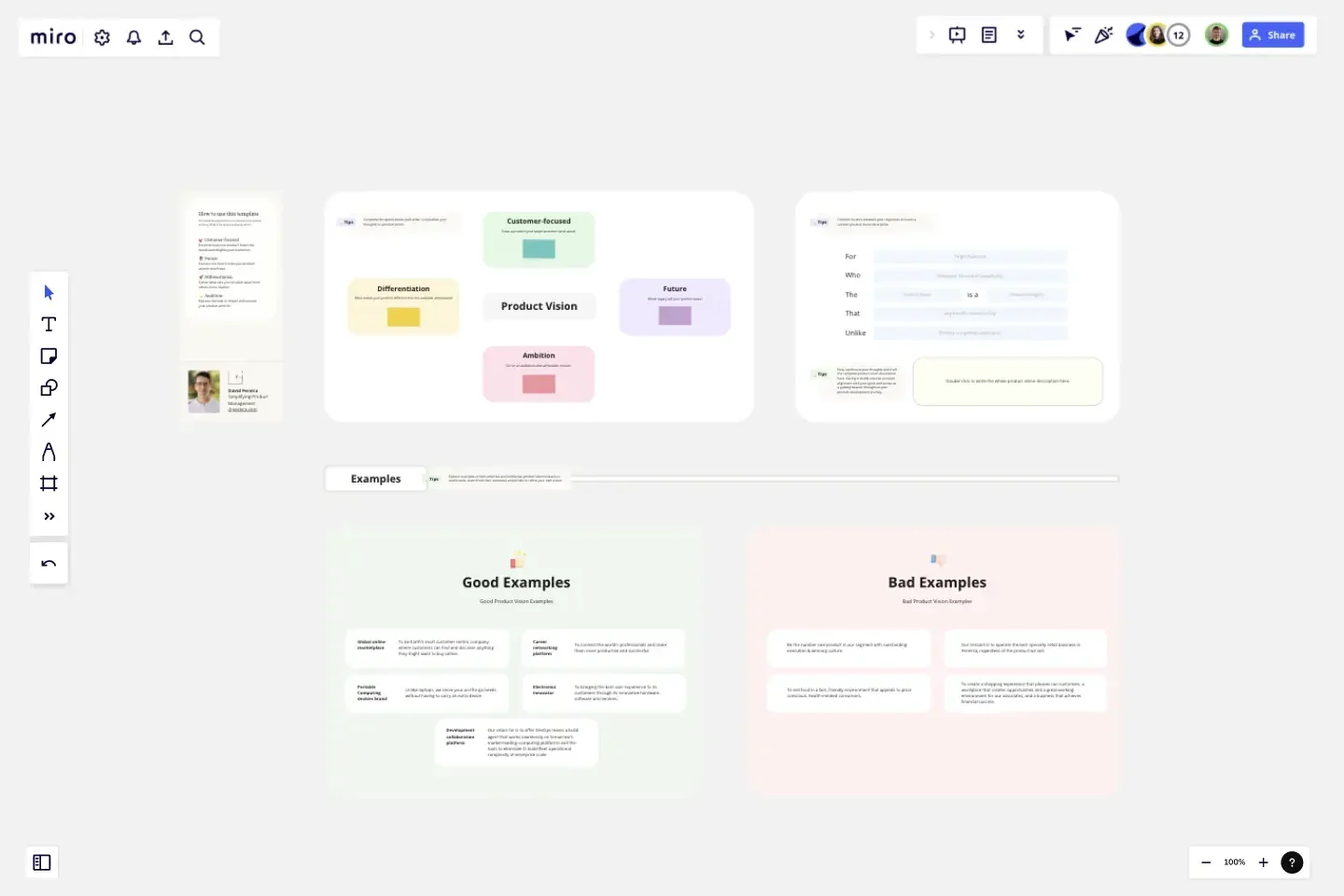Product Vision & Differentiation Strategy Template
This Miro template is the quintessential tool for product managers, entrepreneurs, and marketing strategists dedicated to defining and communicating a product's core essence.
Thoughtfully designed to guide you through the crucial elements of crafting a compelling product narrative that resonates with customers and stands out in the marketplace.The template features structured sections to help you articulate:
Customer Focus: Sharpen your product's appeal by centering on customer needs and experiences, ensuring that your vision is intrinsically linked to user satisfaction.
Differentiation: Pinpoint what sets your product apart, carving out a niche in the competitive landscape that highlights your unique selling propositions.
Future-Oriented Vision: Map out the trajectory of your product's evolution, setting clear expectations for its growth and adaptability in the market.
Ambition: Embrace boldness in your product's mission, reflecting the drive and vision that propel your product forward.
This template includes:
Guided sections to facilitate a holistic approach to product vision development.
Examples of effective product vision statements that capture attention and foster engagement.
Insights into common pitfalls with examples of what to avoid in crafting your product narrative.
Interactive areas for team collaboration, allowing for collective input and refinement of the product vision.
By utilizing this template, you can:
Develop a clear and persuasive product vision statement that aligns with your business strategy.
Differentiate your product effectively, ensuring that its unique value is understood and valued by your target audience.
Foster a strong product identity that guides marketing efforts and product development decisions.
Prepare a solid foundation for your product story that can be articulated across various platforms and pitches.
Ideal for strategic planning sessions, product development workshops, and pitch preparation, our Product Vision & Differentiation Strategy Template is your ally in elevating your product's narrative and securing its position as a market leader.Here are four steps to craft your product vision.
Exchange with high-level management or the product sponsor and strive to understand their vision and the why. Show curiosity and learn what matters to them as much as possible.
Talk to customers and observe how the product helps them. If it’s B2B, understand why they chose your product over the competition.
Look at the available options in the market and clarify what makes yours unique.
Come up with a draft and invite key business stakeholders to sharpen it with you. Iterate a couple of times, but not more than that.
Commit to it and start using it as much as possible. Good options are roadmap, planning, and review. Ensure the product vision is alive, and don’t hide it. Use it whenever you can.
This template was created by David. Discover more product strategy template examples to help you build your next big thing.
Get started with this template right now.
UML Class Messaging System Template
Works best for:
UML
The UML Class Messaging System Template streamlines the process of designing and analyzing messaging systems. It allows users to visually map out the structure of a system by detailing classes, their attributes, operations, and the relationships among objects. This template is particularly useful for illustrating the functionality of a messaging system, including the management of text messages, conversation threads, user contacts, notifications, and channels. It offers a clear visual representation of how all these elements interact within the system, making it an invaluable resource for developers, designers, and stakeholders aiming to enhance communication and reduce errors in the development phase.
Product Management Onboarding Map
Works best for:
Product Management, Planning
Product Management Onboarding Map template facilitates the onboarding of new product management team members. By outlining key responsibilities, processes, and stakeholder interactions, this template helps new hires quickly acclimate to their roles. With sections for setting learning objectives and resources, it supports structured onboarding experiences, ensuring that new team members are equipped with the knowledge and tools needed to contribute effectively to product initiatives.
Lean Canvas Template
Works best for:
Agile Methodology, Strategic Planning, Agile Workflows
Business opportunities can get dense, cumbersome, and complex, and evaluating them can be a real challenge. Let a lean canvas streamline things and break down your business idea for you and your team. A great tool or entrepreneurs and emerging businesses, this one-page business model gives you an easy, high-level view of your idea — so you can stay focused on overall strategy, identify potential threats and opportunities, and brainstorm the various factors at play in determining your potential profitability in an industry.
Agile Product Roadmap (Now, Next, Later)
Works best for:
Product Roadmap
Stay ahead in your product development with the Agile Product Roadmap Now Next Later template. This tool allows you to plan and prioritize features and improvements dynamically, ensuring your product evolves with market needs. Visualize short-term, mid-term, and long-term goals to keep your team focused and aligned. Perfect for product managers and agile teams aiming to deliver continuous value.
Product Vision
Works best for:
Product Management, Planning
The Product Vision template helps articulate a clear and compelling vision for product development. By defining goals, target markets, and success metrics, this template aligns teams around a shared vision. With sections for outlining product features, benefits, and competitive advantages, it communicates the value proposition effectively. This template serves as a guiding light for product teams, inspiring creativity and focus as they work towards bringing the product vision to life and achieving business objectives.
Product Metrics & Analytics
Works best for:
Product Management, Planning
The Compelling Product Offer template assists product teams in defining and measuring key product metrics effectively. By identifying performance indicators, setting benchmarks, and tracking progress, this template enables teams to evaluate the success of product initiatives objectively. With sections for defining KPIs, visualizing data, and analyzing trends, it provides actionable insights for driving product improvements and optimizations. This template serves as a dashboard for monitoring product performance and making data-driven decisions that enhance the overall product offering.
